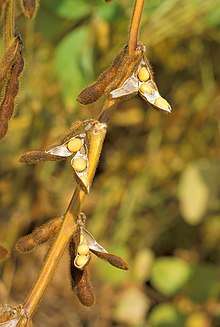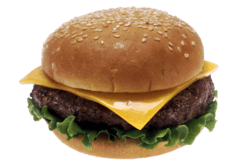Veggie burger
A veggie burger is a burger patty that does not contain meat. These burgers may be made from ingredients like beans, especially soybeans and tofu, nuts, grains, seeds or fungi such as mushrooms or mycoprotein.
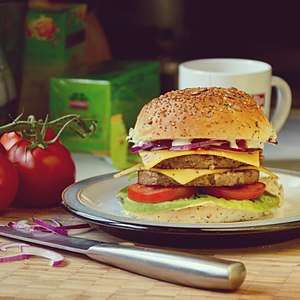 | |
| Type | Sandwich |
|---|---|
| Main ingredients | Vegetables, textured vegetable protein, legumes, nuts, mushrooms, or grains or seeds |
The patties that are the essence of a veggie burger have existed in various Eurasian cuisines for millennia, including in the form of disc-shaped grilled or fried meatballs or as koftas, a commonplace item in Indian cuisine. These may contain meats or be made of entirely vegetarian ingredients such as legumes or other plant-derived proteins.
Origin
While it is not possible, or even necessary, to identify the 'inventor' of the veggie burger, there have been numerous claimants.
The veggie burger, by name, may have been created in London in 1982 by Gregory Sams, who called it the 'VegeBurger'. Gregory and his brother Craig had run a natural food restaurant in Paddington since the 1960s;[1] a Carrefour hypermarket in Southampton sold 2000 packets in three weeks after its launch.[2] An earlier reference can be heard in the June 7, 1948 episode of Let George Do It called "The Mister Mirch Case" where a character refers to "vegeburgers," as a burger made of nuts and legumes.
Using the name Gardenburger, an early veggie burger was developed by Paul Wenner around 1980 or 1981 in Wenner's vegetarian restaurant, The Gardenhouse, in Gresham, Oregon.[3]
Restaurants
Some fast food companies have been offering vegetarian foods increasingly since the beginning of the 21st century.
India
In India where vegetarianism is widespread, McDonald's, Burger King, Wendy's and KFC serve veggie burgers.[4][5][6] In 2012, McDonald's opened its first vegetarian-only restaurant in India.[7]
United States
In the United States as of April 2005, veggie burgers became available in Burger King restaurants and those of its franchise Hungry Jack's.[8] As of that same time, they were also available in certain Subways and Harvey's, as well as many chain restaurants, such as Red Robin, Chili's, Denny's, Friendly's, Culvers, Johnny Rockets, and Hard Rock Cafe. Occasionally the veggie burger option will appear at the bottom of a menu as a possible substitution for beef or turkey burgers, rather than as an individual menu item.
McDonald's
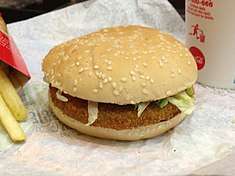
Different kinds of veggie burgers are also served permanently in McDonald's restaurants in:
- India (McVeggie, consisting of a fried, breaded patty of ground vegetables, with lettuce and ketchup, in a wholewheat, sesame or foccacia bun)
- Bahrain[9]
- Cheung Chau, Hong Kong (McVeggie, in Cheung Chau Bun Festival)
- Egypt (McFalafel, consisting of a falafel patty with tomato, lettuce and tahini sauce)[10][11]
- Finland (McVegan)[12]
- Germany Since February 2010, McDonald's Germany, its fourth-biggest global market, is serving veggie burgers in all its restaurants.[13][14]
- Greece (McVeggie, consisting of a breaded and fried vegetable patty with tomato, iceberg lettuce and ketchup, in a sesame bun)[15]
- Malaysia[16]
- The Netherlands (Groentenburger=Vegetable Burger)[17]
- Portugal (McVeggie, since November 2016)[18]
- New Zealand (McVeggie, since December 2019)[19]
- Sweden (McVegan)[20]
- Switzerland (Vegi Mac)[9][21][22]
- United Arab Emirates[23]
- United Kingdom MacDonald's are notable as the only major UK burger chain that does not offer a meat-substitute or meat-like burger product, instead using a partly mashed mixed vegetable product (Vegetable Deluxe)[24][25]
Manufacturing process
Manufacturing often follows certain steps. One commercial recipe runs as follows.[26][27]
The grains and vegetables used in the patties are first washed and thoroughly cleaned to help ensure the removal of dirt, bacteria, chemical residues, and other materials that may be on the raw products. This process can either be done by hand or through the use of machinery such as high-pressure sprayers. With the use of a conveyor belt, the food is moved along under a high-pressure sprayer to remove the debris listed above. Another method that may be used by companies is the use of a hollow drum which circulates the food while water is sprayed onto it to remove the debris.
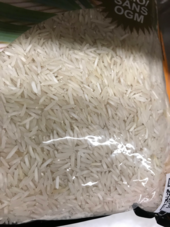
Next, a steam-heated mixer is used to cook the grain and remove any extra debris and excess water. The mixer typically has oils within it (such as safflower oil). As the oil simmers, the grains are gradually added in and the blades are used to mix the grains around. The steam created in the mixer allows the grains to cook resulting in a puree.
Next the vegetables are cut up into smaller pieces to allow more surface area for cooking purposes. This can be done by hand or through the use of machines in factories.
The vegetables are then added to the grain mixture in the steam-heated mixture. The exact ratio of grains to vegetables is unique to each company, resulting in different textures and tastes that are produced.
As the vegetables are being cooked in the mixer, their natural sugars release, resulting in caramelization. The sweet flavors thus created from this caramelization are mixed uniformly in the mixer. The technique used for the creation of this caramelization mixture is called mirepoix. This technique is very important to the production of veggie burgers, as it adds both texture and flavor to the patty.
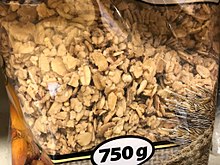
The mirepoix mixture is then placed into another mixing tub, where dry ingredients such as oats, walnuts, potato flakes, and more are added. The mixture is then folded together to make a uniform mix. The moisture from the vegetables causes the mixture to become sticky, thus clumping together like cookie dough. This is important, as it allows the veggie burger to stick together to form the patty.
The mixture is now put into an automatic patty-making machine or press. The press then punches out the patties into a disc shape onto a conveyor belt underneath. A constant spray of water may also be used to prevent any of the mixture from sticking to machinery parts. Once on the conveyor tray, the patties move along to be put onto baking trays.
Patties are first inspected to make sure they are the correct shape, size, and texture to ensure a high-quality product. The trays are then put into a heated convection oven at a designated temperature and time.
Once out of the oven, the patties are quickly frozen with techniques such as individual quick freezing and cryogenic freezing.[28] These quick-freezing methods freeze the patties within 30 minutes to lock in nutrients and preserve texture by the formation of a number of small ice crystals.
The frozen patties are again placed on a conveyor belt that takes them to a vacuum-packaging machine. The machine seals the patties into measured plastic sleeves and draws out any excess air. The packages are then loaded into printed cardboard boxes with the aid of another machine or done manually. The flaps on the box are then sealed closed and the product is kept in temperature-controlled storage before, during, and after delivery to grocery stores.
Ingredients purpose
Grains
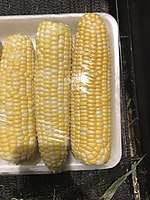
Grains are primarily used in the manufacturing of veggie burgers to act as a meat substitute. The grains, such as rice and wheat, provide carbohydrates and protein components and to provide bulk to the patty. They also provide texture to the burger, which can change depending on the type of grain used. This texture and look is important as they wish to make the patty look like a beef patty.
Vegetables
Vegetables such as corn, carrots, and mushrooms, provide the patty with texture and taste. Additionally, they provide moisture when heated.[29] This allows the disc shape without breaking apart easily. The vegetables also provide nutrients with the addition of some vitamins and minerals.[30]
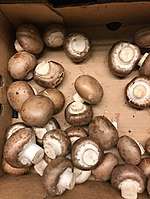
Dry ingredients
Adding dry ingredients, such as oats, flours, nuts, or breadcrumbs, can absorb excess moisture and liquid, which results in the patty sticking together tightly. This could turn the moist veggie patties into a sticky consistency, which also helps the patties shape easily.[29] Dry ingredients provide proteins and fiber, which add nutritional value to the veggie patty. Dry ingredients, such as walnuts and almonds, are also rich in energy, vitamins and minerals.[31]
Stabilizers
Tapioca starch and vegetable gum are two common ingredients used as stabilizers in veggie burger. Tapioca starch is often used as a thickening agent for manufactured foods due to its cheaper price. It gets sticky once it is wet, which helps to hold the burger patty tightly together.[32] This prevents the patty from breaking apart. Vegetable gum provides negligible nutrients, but it also helps to hold everything together in the patty.[33]
Oils
Oils, such as safflower, coconut, and olive oil, can lubricate the grain mix, and allow further cooking processing when the wheat is added. It facilitates the Maillard reaction and makes the veggie patty taste better by bringing out the flavors. Oils can also prevent the ingredients from sticking to the mixing machine, thus allowing them to be mixed well and heated together.[34]
Preservatives
Salt is typically used for flavor, but may be used as a preservative in veggie burgers. With the use of salt, the water activity of the food is reduced. This helps prevent the growth of micro-organisms and prolongs the shelf life of the food.[35]
Gallery
 A Burger King Veggie combo meal, including a veggie burger, from Germany
A Burger King Veggie combo meal, including a veggie burger, from Germany.jpg) Vegan burger and chips
Vegan burger and chips Vegan burger
Vegan burger Example of vegan veggie burger
Example of vegan veggie burger
See also
- Beyond Meat – Los Angeles-based producer of plant-based meat substitutes
- BK Veggie
- Boca Burger
- Coconut burger
- Gardenburger
- Impossible Burger
- List of hamburgers – Wikipedia list article
- List of meat substitutes – Wikipedia list article
- List of sandwiches – Wikipedia list article
- List of vegetable dishes – Wikipedia list article
- Meat analogue
- Morningstar Farms
- Quorn
- Sanitarium Health and Wellbeing Company
- Soy pulp
- Vada pav – Indian fast food item
- Veganism – Practice of abstaining from eating or otherwise using animal products
- Vegetarian cuisine – Food not including meat
- Vegetarianism – Practice of abstaining from the consumption of meat
References
- "The Vegeburger story". Chaos Works. Retrieved 11 November 2006.
- "And Here Comes the VegeBurger". The Observer. UK. Retrieved 11 November 2006.
- "Inventor of the Week – Paul Wenner". MIT. Archived from the original on 11 December 2004. Retrieved 27 July 2012.
- "Rediff On The NeT: Meatless Burgers Gain Popularity Across America". www.rediff.com.
- McDonald's new TVC pushes McChicken, McVeggie products Indiantelevision.com
- "Burger King Brings Beef-Free Whoppers to India". Wall Street Journal. 30 October 2014. Retrieved 6 November 2014.
- "McDonald's opens vegetarian-only restaurant". BBC.
- Hungry Jack's. "Veggie Burger". Archived from the original on 5 May 2009. Retrieved 7 May 2009.
- "The Love Burger, Seaweed Fries, and Other Curiosities". Tikifish.com. Retrieved 20 November 2011.
- "About.com Middle Eastern Food: McFalafel". Mideastfood.about.com. 17 June 2010. Archived from the original on 16 January 2013. Retrieved 20 November 2011.
- "McDonald Introduces McFalafel, Just for Egypt". Touregypt.net. Retrieved 20 November 2011.
- Suomi, McDonald's. "McVegan™". www.mcdonalds.fi. Retrieved 17 March 2019.
- "Veggie burger, coffee to fuel McDonald's in Germany". Reuters. 9 February 2010. Retrieved 20 November 2011.
- "McDonald's veggie burger page at the German McDonald's homepage". Mcdonalds.de. Retrieved 20 November 2011.
- "McVeggie burger - McDonalds". 5 April 2010. Archived from the original on 5 April 2010.
- "McDonald's Malaysia Drive-Thru Challenge - Hot-screensaver". 21 August 2008. Archived from the original on 21 August 2008.CS1 maint: BOT: original-url status unknown (link)
- "McDonald's Netherlands: Groenteburger (Vegetable Burger)". Mcdonalds.nl. Retrieved 20 November 2011.
- "McDonald's Portugal: McVeggie". Mcdonalds.pt. Retrieved 8 May 2017.
- Woodyatt, Amy. "In New Zealand, McDonald's new McVeggie burger is not strictly vegetarian". cnn.com. CNN. Retrieved 27 December 2019.
- "McVegan". www.mcdonalds.com. Retrieved 17 March 2019.
- "McDonalds Food from Around the McWorld". Nowthatsnifty.blogspot.com. 22 July 2009. Retrieved 20 November 2011.
- "McDonald's Switzerland: Vegi Mac". Mcdonalds.ch. Retrieved 20 November 2011.
- "mcdonalds veggie burger calories?". 5 December 2008. Archived from the original on 5 December 2008.
- "Vegetable Deluxe - Vegetable Burger - McDonald's UK". www.mcdonalds.com.
- "Spicy Vegetable Deluxe - Vegetable Burger - McDonald's UK". www.mcdonalds.com.
- How It’s Made (27 May 2015), How It's Made Veggie Burgers, retrieved 3 August 2017
- "How vegetarian burger is made - making, processing, product, industry, machine, Raw Materials". www.madehow.com. Retrieved 3 August 2017.
- Gibbs, W. Wayt; Myhrvold, Nathan (2011). "Cryogenic Cooking". Scientific American. 305 (2): 31. Bibcode:2011SciAm.305a..31G. doi:10.1038/scientificamerican0811-31. PMID 21827120.
- "The Ultimate Veggie Burger Guide | Perfect veggie patties | Gourmandelle". Gourmandelle | Vegetarian Blog. 25 August 2014. Retrieved 3 August 2017.
- "Mirepoix: This Simple Veggie Trio Will Change the Way You Cook Forever! | One Green Planet". www.onegreenplanet.org. Retrieved 3 August 2017.
- "Nuts nutrition facts and the health benefits of nuts". Nutrition And You.com. Retrieved 3 August 2017.
- "Tricks for Making Veggie Burgers That Won't Fall Apart | One Green Planet". www.onegreenplanet.org. Retrieved 3 August 2017.
- "What's Inside Your Veggie Burger? | Care2 Healthy Living". www.care2.com. Retrieved 3 August 2017.
- Bailey, Milton E.; Um, Ki Won (5 August 1992). Lipid Oxidation in Food. ACS Symposium Series. 500. American Chemical Society. pp. 122–139. doi:10.1021/bk-1992-0500.ch008. ISBN 978-0841224612.
- "How to Choose a Healthy Veggie Burger Without Harmful Ingredients | One Green Planet". www.onegreenplanet.org. Retrieved 8 August 2017.
External links
| Wikibooks Cookbook has a recipe/module on |
| Wikimedia Commons has media related to Veggie burgers. |
